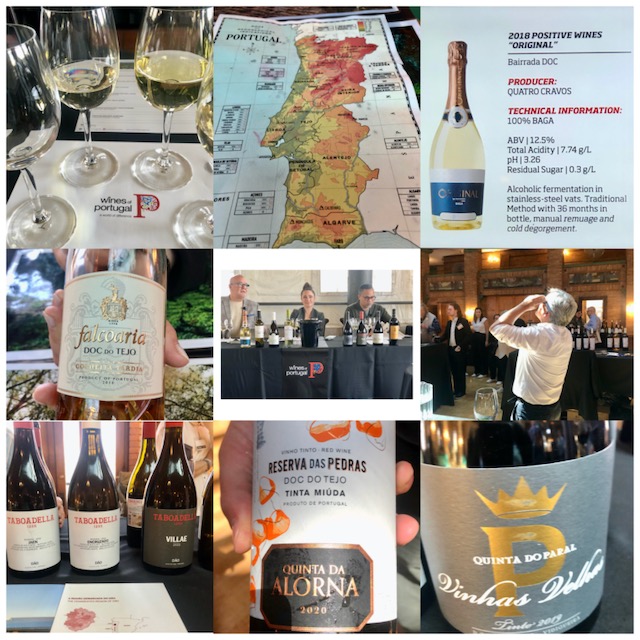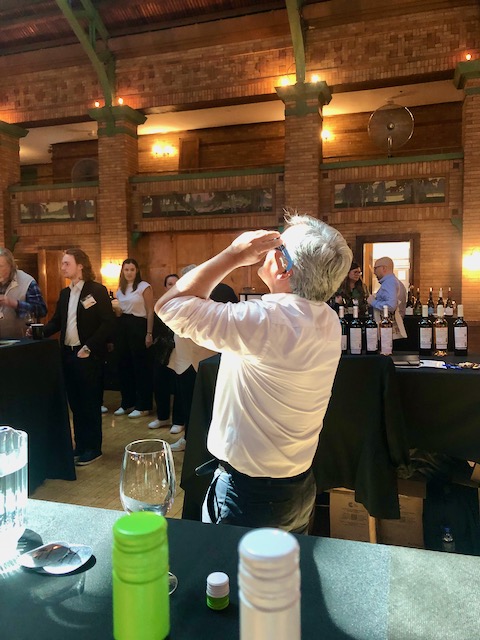
Monday, April 8, 2024 was an auspicious day, a full lunar eclipse. In Chicago, we were able to view 94% of the total eclipse. The next total eclipse won’t take place for another 20 years. I viewed it (not me in the photo) from Cafe Brauer at the Lincoln Park Zoo, during the Wines of Portugal annual tasting. It was a perfect spot. The event room had a sun roof, so we could look up, with the viewing glasses on of course, to see the eclipse, while tasting some delicious Portuguese wines. The room was full of eclipse energy, which added a joyous lift to an already fun event. A fantastic midday of traveling by the glass to sunny Portugal!
Maybe it was the eclipse energy in the room, or perhaps the excellent master class given by Eugenio Jardim, the Portugal USA Brand Ambassador along with Rachel Lowe, Beverage Director at Levy Restaurants and Gary Obligacion, Director of Development at the Alinea Group, but Portuguese wine regions and grapes are beginning to seem more familiar rather than new. Eugenio lead us through some of the major wine regions, glass by glass and cited some interesting factoids. Portugal, a country the size of the US state of Indiana, has over 250 native grape varieties and is the 6th largest exporter of wine worldwide by country. Eugenio pointed out, Portugal and Argentina tend to duke it out for that spot, currently Argentina is number 7 in wine exports. Lastly, I remembered 200% but when I checked my notes, tourism increased 300% in 2022. Even if you take into account the effects of Covid on travel, that still is a big number. Where tourism goes, interest in food, wine and beverages increases.
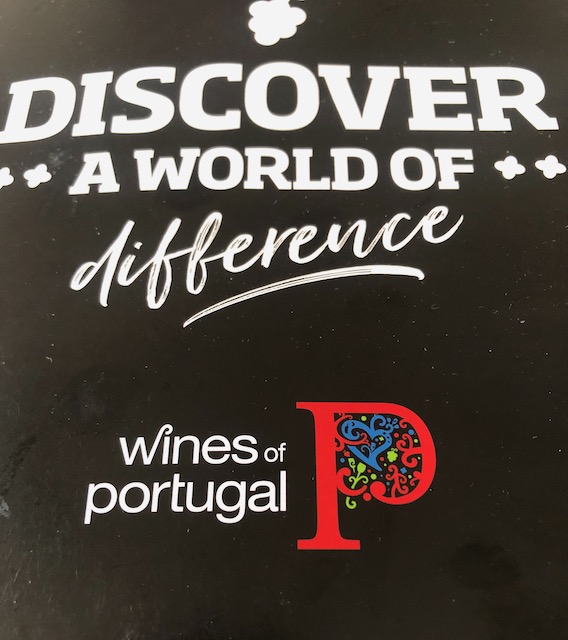
The theme of the class was “Portugal in 8 Glasses”. We tasted wines from some of the major regions, Bairrada, Vinho Verde, 2 from Dão e Laföes, 2 from Alentejo, Lisboa, and Porto e Douro. Portugal has 31 DOCs and 14 Regional wine appellations IGPs. This succinct group of 8 wines focused on the absolutely must-know regions, but really, was just the tip of the Portuguese wine iceberg. These regions seem more and more familiar each time I taste wines from them.
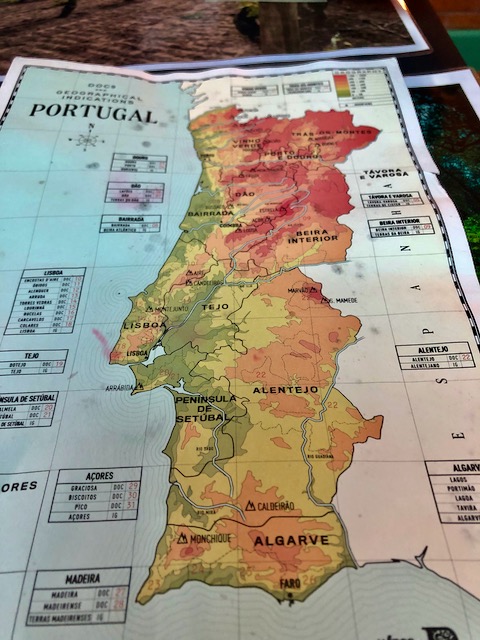
The first wine, was a super dry, fresh, crisp sparkling, from the Bairrada (pronounced Bahada), using the traditional method with the Baga grape, 2018 Positive Wines, produced by Quatro Cravos. The Bairrada region sits just below the Minho Vinho Regional (VR), right along the Atlantic ,within the larger VR Beira Atlântico and is home to the red Baga grape. Eugenio called it, “Portugal’s nebbiolo, tannic as hell when young and delicious when aged”. This Blanc de Noir was aged 36 months on the lees and had a slight cherry biscuit-ness to it. A great start to the morning.
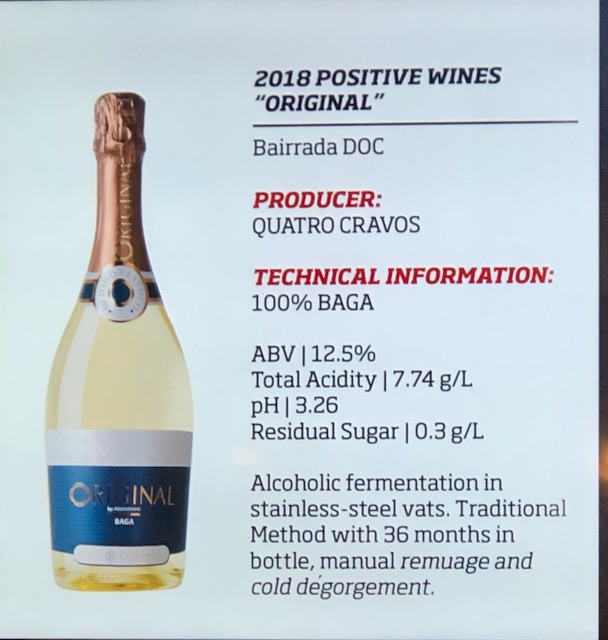
The next group of 3 white wines were from Vinho Verde, Dão E Lafões and the Alentejo. Vinho Verde is a style of wine, light, slightly effervescent, lower alcohol and lower price wine. However, VV is also a wine region and part of the larger, Minho Vinho Regional and composed of 9 subregions: Amarante, Ave, Bāo, Basto, Cávado, lima, Monçāo e Melgaço, Paiva and Sousa, The wine we tasted was Raza Alvarinho-Trajadura White 2023 from the subregion of Basto. Eugenio’s comment. “it rains a lot” in Vinho Verde. The grapes are grown on granitic soils, the wine was 60% Alvarinho, 40% Trajadura, residual sugar of 6 g/l, the wine rested 4 month on the lees giving it, what Gary characterized as a “grip on the mid-palate” and Eugenio focused on the tart guava quality of the fruit from the Trajadura grape. This was not the typical Vinho Verde style that most consumers assume, when they think Portuguese whites.
Next up, for wine number 3 was the Casa Americo 625 white 2020 from the region of the Dāo e Lafões, within the larger Terras do Dāo VR, located just east of the Beira Atlāntico VR. The Dāo region is surrounded by mountains and is the birthplace of the red grape, Touriga Nacional, that is an important grape for Port. Here the Spanish red grape Mencia grows and is called Jaen. The soils are granitic. Eugenio characterized the Dāo as “the Burgundy of Portugal”. This wine was made from 80 year old vines (Vinhas Velhas) of the major white grape of the Dāo, Encruzado within one of the 7 subregions, Serra da Estrella. The wine had concentration and richness from the old vines and spice from wood ageing.
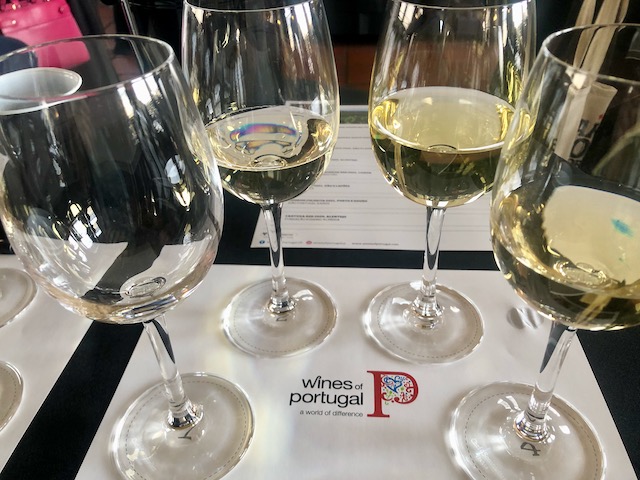
The last of the whites was from the Alentejo region in the south of Portugal. The Alentejo is the bread basket of the country producing grains, grazing lands for herd animals, cattle and pigs, olive trees and most importantly cork trees. The Alentejo produces the largest share of quality wines to the domestic market, they must be making something good!! At this part of the tasting, halfway through, it was emphasized that Portugal wine is focused on “sustainability above all“. I personally really loved hearing this, because most US wines that are produced at the same price point, as some of these Portuguese wines, use industrial methods, in order to produce the wine at a lower price. Not all, but most Portuguese wines, are coming in at lower price points relative to their quality. It is fantastic, that even at these price points, the wines are being produced sustainably with fewer chemicals in the vineyard. This last white wine, the Reguengos White 2022 , 70% Siria (Roupeiro), 30% Anton Vaz is produced by a cooperative of 850 producers. I didn’t write much about the characteristics of this one, except a note on the side of the tasting sheet, “really liked this one. “
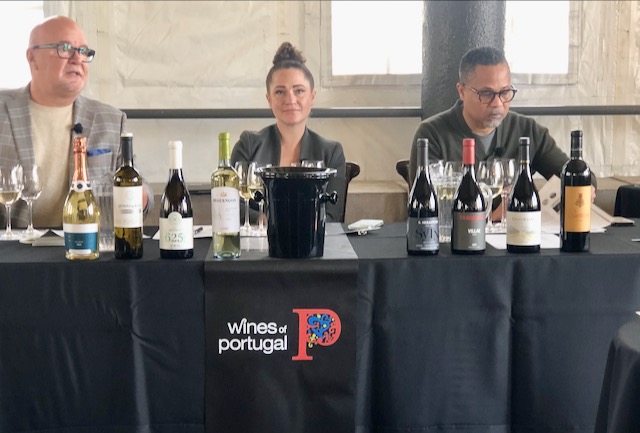
The group of 4 reds included the regions of Lisboa, Dāo e Lafões, Porto e Douro and the Alentejo. The region of Lisboa is the hilly coastal region to the west and north of the capital city of Lisbon. It has the most DOCs of any other region, 9 and is part of the larger VR named as well, Lisboa. The region has a heavy Atlantic influence and is the westernmost of the vineyards of Europe. Interestingly, it is one of the few regions to allow international grape varieties. The red we tasted was Sāo Sebastiāo Reserva Red 2021, 38% Merlot, 37% Touriga Nacional, 25% Syrah. Red and black fruit, with incense and floral aromas that Eugenio attributed to Touriga Nacional.
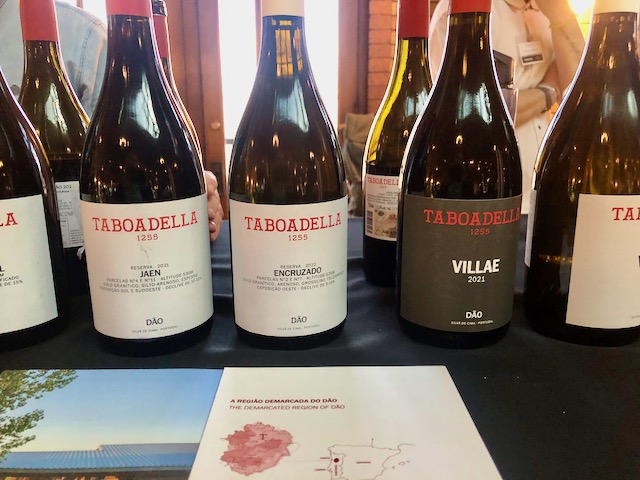
The second red was from Dāo e Lafões, Villae Red 2021 produced by Taboadella , the site of an ancient Roman Village in the Dāo. The Amorin family are owners of the wine company and have been involved with wine since 1870, when they produced cork stoppers for Port. Today, Luisa Amorin runs the company and they are focused on wines made from indigenous varietals sourced from the Dāo and the Douro. Rachel commented that she loves red wines from the Dāo, due to the fact the grapes are grown at higher elevations and finds they have “a cranberry, cranapple, crunchy character”. Gary said that you will not see “over-oaked but under-fruited wine”. The wine we tasted was a red blend of 40% Tinto Roriz (Tempranillo), 20% Jaen (Mencia), 20% Tinto Pinheira and 20% Alfrocheiro and aged for 15 months in reinforced concrete Nico Velo Tulipe tanks. They suggested serving a wine like this with roast chicken, in place of a Pinot Noir.
Our third red was from the Porto e Douro region, the region most people will have some familiarity with because of Port wines. The Douro was the first demarcated wine region in the world in 1756. The soils are primarily decomposing schist, so grape roots can grow deep into the soils for water and nutrients. The Vinho Regional for these subregions is VR Duriense. The wine was Duorum Colheita 2021 produced by Joāo Portugal Ramos and a blend of Rabigato, Gouveio (Godello), Arinto and Codega do Larinho.
The final red was from the Alentejo, Cartuxa Red 2020. The wine was a red blend of old vines from the vineyards of the charitable organization Fundacāo Eugenio Almeda . The blend was composed of Alicante Bouschet, Aragonez (Tempranillo), and Trincadeira. Cherry, plum, blackberry, a good food wine to complement meat dishes.
The eclipse took place after the class had finished but during the grand tasting. There was a diverse group of producers pouring with still, sparkling and sweet wines. So, what did I have in my glass during the eclipse? It was a late harvest wine from the Tejo region which encompasses the vineyards around the Tejo river (Tagus river in Spain) and the VR is named Tejo as well. It is situated to the east of Lisboa and just above the Alentejo (below the Tejo). It was a tasty, sweet sipper of Viognier and Fernāo Pires. Mango, tangerine, ripe apricot with a brightness to it and concentration of flavor. A great wine to savor as the eclipse took place.
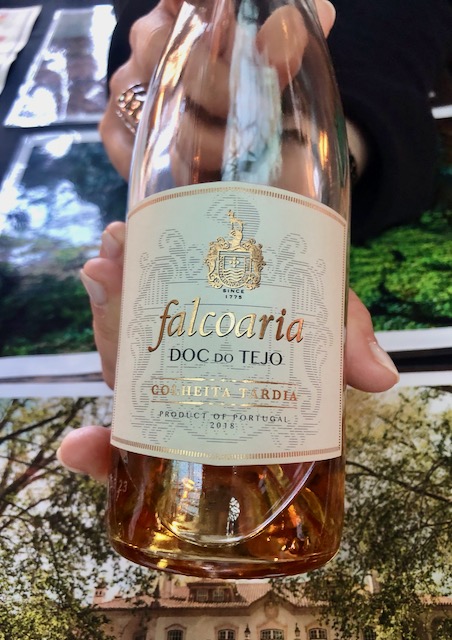
This event and class, was a really fun way to further my knowledge of Portugal and to enjoy the eclipse in style. Thank you to everyone who had a hand in making this happen. Traveling by the glass can be so fun!!!!!!!!!!!!
9

